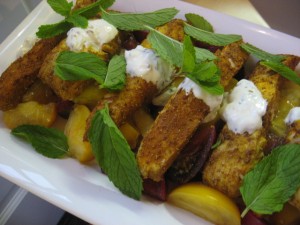 For over three years now, I have participated in a cookbook club comprised of graduates from the professional program at Tante Marie’s Cooking School in North Beach. Each month, one of us chooses a book of interest and a recipe to cook. Then as a group, we share our choices via Evite and develop a complete and eclectic menu. While we enjoy the company of friends and colleagues over a great meal, we also learn new cooking techniques and stay abreast of food trends.
For over three years now, I have participated in a cookbook club comprised of graduates from the professional program at Tante Marie’s Cooking School in North Beach. Each month, one of us chooses a book of interest and a recipe to cook. Then as a group, we share our choices via Evite and develop a complete and eclectic menu. While we enjoy the company of friends and colleagues over a great meal, we also learn new cooking techniques and stay abreast of food trends.
This month, I hosted the club at my house. My cookbook choice, David Tanis’ A Platter of Figs, resulted from my experience assisting him during a class he taught at Tante Marie’s. His use of fresh seasonal ingredients and simple preparations left a lasting impression on me – not surprising since he was the head chef at Chez Panisse for many years. David now lives in Paris and runs an underground restaurant 6 months of the year.
For our dinner, I selected a delicious recipe, Indian-Spiced Halibut with Spicy Yogurt Sauce. I purchased fresh halibut at Bryan’s Market in Laurel Village. Though Bryan’s prices are expensive, their fish market is the best in town. Since I wanted to wow my guests, I decided to go for it! Everyone knows that good dishes start with good ingredients, but every good ingredient can always get better and my secret weapon was brine.
I always brine bland fish – a trick I learned from Jacques Pepin when I worked on his TV show many years back. His tip for making the brine is simple. First, he fills a bowl with salt water then adds a good amount of kosher salt and mixes it until dissolved. Next, he puts a whole, uncracked egg in the water. If the egg is buoyant, he knows he has enough salt in the water. If it sinks, he adds more salt until the egg becomes buoyant. Finally, he immerses the fish in the water for 30 minutes. When I applied this technique to my halibut recipe, I received rave reviews! Everyone commented that it was quite moist and flavorful. A Moroccan spice rub also offered a flavor boost, however I knew from experience that spice rubs alone can’t hide dry fish, while brining wins every time. Another tip for cooking fish – allow cooking time of 10 minutes for every inch of thickness.
Brining aside, I had another trick up my sleeve for the halibut. While the fish was delicious, the true piece de la resistance that took it over the top was the yogurt sauce. I used Greek yogurt which has most of the whey removed, rendering it thick and creamy. David Tanis says to sauté the spices (cumin and mustard seed) in olive oil which I did. But I also added some coarsely ground coriander. Once the spices were fragrant and crackling on the stove, I added the garlic AND the Serrano (he says only the garlic but I wanted a quick sauté of the Serrano too). I stirred this mixture into the yogurt then added a good amount of kosher salt and some ginger juice. (To create ginger juice, just grate a hand of ginger on the large holes of a box grater and squeeze the juice out by tightening your fist). After tasting, I decided I wanted more acid. I added the juice of half a lemon but also some preserved lemon rind. Lastly for color, I added a bit of chopped cilantro.
The yogurt was a huge hit – everyone was eating it on everything – the Berber Pizza, a dollop in the Harira Soup and on the Halibut itself which is what it was intended for. (I am now making some to dollop on my Lamb Pizza for dinner tonight).
All in all, we loved the book and would highly recommend it.

; ?>/img/parties-that-cook-blog-logo.jpg)

